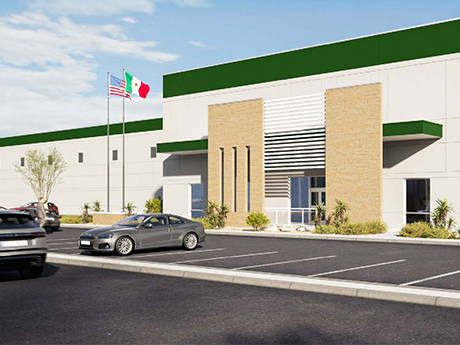By Enrique Volkmer, associate at Lee & Associates
Laredo, Texas, has emerged as one of the largest ports in the world by volume and crossings, driven by its robust infrastructure and strategic location.
According to 2023 data from the U.S. Census Bureau, the Port of Laredo was responsible for handling an aggregate amount of product valued at about $320 billion, the most in the country by that metric. In addition, a 2024 article from Transport Topics, citing data from the Laredo Economic Development Corp., stated that the Port of Laredo sees more than 5.5 million truck crossings per year. The article also noted that the port is home to 660 trucking and transportation companies, 250 freight forwarders and 120 U.S. Customs brokers.

Recent analysis of freight costs conducted by LoadWise 3PL and OL Logistics found that shipping product from Laredo to several major destinations, including Detroit, Atlanta, Indianapolis and Pittsburgh, actually yields savings compared to shipping from Houston to those cities, all other factors being held equal. The same study revealed a cost advantage when shipping westward from Laredo instead of Dallas to select markets such as Los Angeles, Denver, Seattle, Salt Lake City and San Francisco.
Freight is often cheaper to ship from Laredo than other more established distribution hubs due to the city’s status as a “backhaul” market. This means that there is more product from northern cities and states coming back to Mexico as opposed to final destinations like Dallas or Houston. The dynamic not only optimizes transportation costs and supports demand for industrial space in Laredo, but also helps ensure that labor costs are lower relative to more established Texas distribution hubs.
Visible Supply Growth
A key factor in this growth is the city’s well-developed industrial parks, which can comfortably accommodate larger warehouse facilities. This expansion has transformed supply chain dynamics, offering a cost-effective alternative for warehousing and distribution compared to traditional hubs like Houston or Dallas.
As an industrial market, Laredo has always been viewed and used as a stepping point for supply chain operators to perform customs and forwarding operations. Now, Laredo has the capability to distribute and be considered a true logistics hub that represents actual supply chain efficiency and has set the foundation for this to happen, as evidenced by almost every major third-party logistics (3PL) carrier in the country setting up shop in Laredo. In addition, the market now features Class A industrial buildings that are at par with any other major distribution or logistical hub in the country.
Among the newer industrial developments that are in some stage of active development and will add new industrial product to the region within the next 12 to 18 months are:
- Standard Real Estate and Chicago-based Brennan Investment Group’s 433,000-square-foot building within Pinnacle Industry Center
- Axis and Menlo Equities breaking ground on a 213,781-square-foot facility that will be known as Vidal Cantu Industrial Center
- Indianapolis-based Scannell Properties and Atlanta-based Invesco Real Estate partnering on the second phase of Laredo Logistics Crossing, which will feature two buildings totaling 327,600 and 259,067 square feet
- Maryland-based investment manager Realterm and regional owner-operator Titan Development partnering on a 440,300-square-foot development
Although smaller than major U.S. logistics centers, Laredo is rapidly evolving. In the process, the market is attracting 3PL providers that are eager to streamline operations. Historically a stepping stone to larger distribution hubs, Laredo is now establishing itself as a primary distribution center. The city also offers distinct advantages for businesses.
With more freight moving southbound into Mexico from Laredo than from cities like Dallas or Houston, the city’s industrial facilities and operators remain crucial links in the supply chain. Laredo’s strategic position along I-35 provides seamless connectivity, reinforcing its status as the most efficient crossing point between the United States and Mexico.
Emerging Cross-Border Trade Hub
While Laredo leads the way, nearby Eagle Pass and its Mexican sister city, Piedras Negras (located in the state of Coahuila), are gaining traction as emerging trade hubs. Currently operating at less than 30 percent of its capacity, the industrial market of Eagle Pass presents a unique opportunity to ease congestion in Laredo while supporting overall trade expansion.
Infrastructure investments, such as the development of Empire Industrial Park, are positioning Eagle Pass as a viable alternative for cross-border shipments. Coahuila, a major manufacturing hub in Northern Mexico, currently routes 70 percent of its exports through Laredo. Redirecting some of this volume to Eagle Pass would not diminish Laredo’s significance but rather serve as a “pressure relief valve,” fostering sustainable growth for both cities.
Trade between the United States and Mexico should continue to expand in the long run, which will elevate Laredo’s dominance as a logistics hub. However, the current administration’s trade policies and tariffs raise questions in terms of how much trade activity — and by extension, demand for industrial space — will be impacted in the short run. While the uncertainty surrounding these policies continues to cause freight and logistics operators — and the brokers who represent them — to delay and rethink real estate decisions, optimism remains for more situational clarity in the coming weeks.
The rise of secondary ports like Eagle Pass will complement this growth, creating a more balanced and efficient trade network. Together, these ports will shape the future of cross-border logistics, solidifying South Texas as a vital force in global supply chains.


